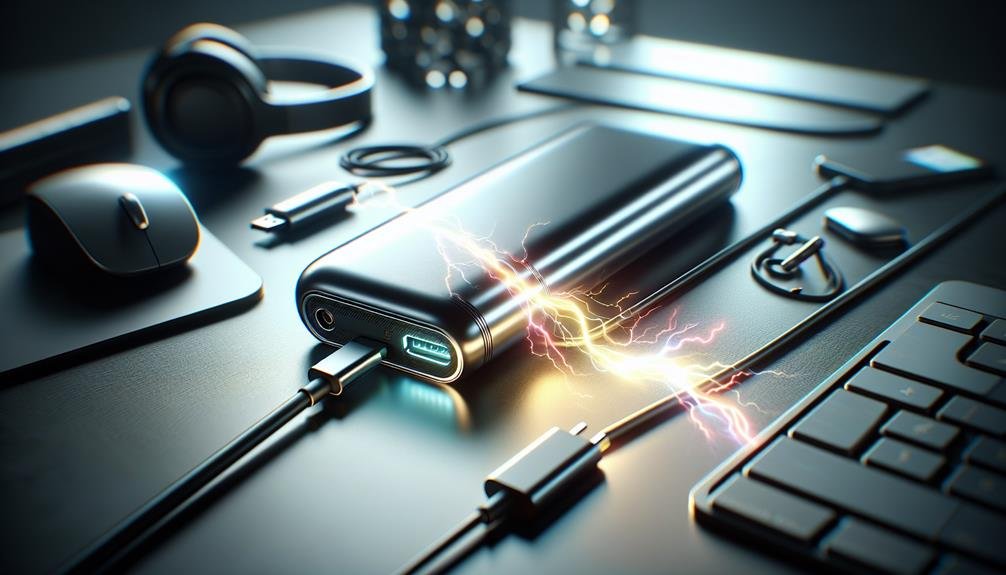To quickly charge your power bank, make sure it supports fast charging technologies like Qualcomm Quick Charge or USB Power Delivery. Use a high-quality charger matching your power bank's input power rating, and prioritize cables with good efficiency and safety certifications. Maintain your power bank in a cool, well-ventilated area to avoid overheating. Monitor charge levels to prevent full discharges. It's also essential to use certified chargers and cables to guarantee best efficiency and safety. Quality cables mitigate heat risks and enhance durability. For more detailed insights on maintaining speed and safety, there's additional information to explore.
Understanding Fast Charging
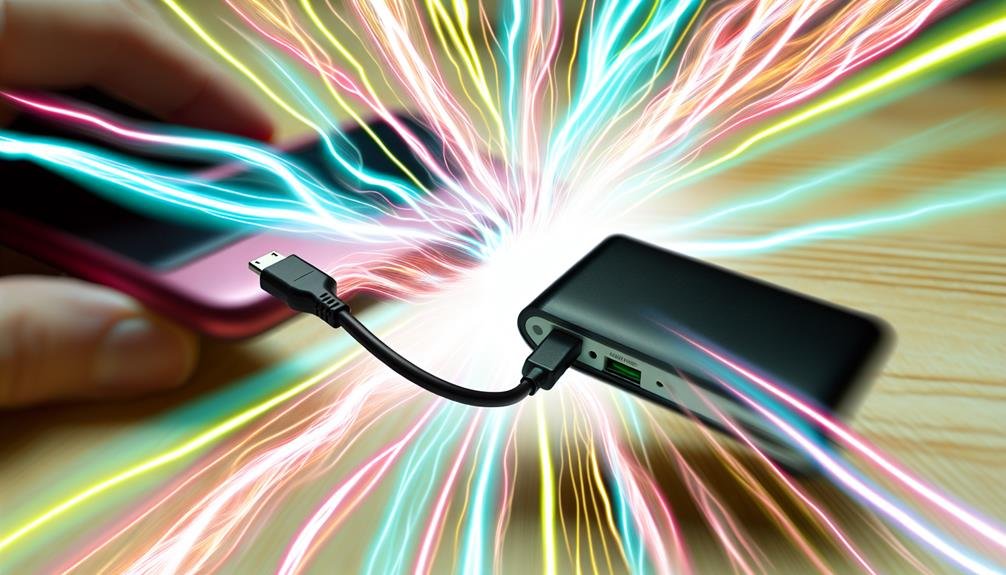
To comprehend quick charging, you need to grasp how it boosts the power transfer rate to your device by optimizing voltage and current levels. Quick charging fundamentally works by delivering higher wattage compared to standard charging methods. This involves precisely controlling the voltage and current to guarantee your power bank charges more rapidly without compromising safety.
Charging speed, an important factor, is greatly improved through quick charging protocols like Qualcomm Quick Charge, USB Power Delivery, and others. These protocols dynamically adjust the power flow, making sure that your device gets charged efficiently while preventing overheating and overloading. The key here is the balance between high-speed charging and maintaining safe operational parameters.
Battery longevity is another vital aspect to take into account. Quick charging can generate more heat, which, if not properly managed, could degrade the battery over time. However, modern quick charging technologies include advanced thermal management systems and battery protection circuits to mitigate this risk. They guarantee that despite the increased charging speed, the battery's health and lifespan are not negatively affected. It's important to use certified chargers and cables to maintain this delicate balance and ensure both your safety and the longevity of your power bank's battery.
Choosing the Right Power Bank
Choosing the correct power bank is crucial for ensuring efficient and safe charging, calling for an understanding of key specifications like capacity, output power, and compatibility with your devices. First, consider the battery capacity, typically measured in milliampere-hours (mAh). A higher mAh rating allows for more charges, but also increases size and weight. Select a capacity that matches your usage needs without being burdensome.
Next, evaluate the design features. These include the number of output ports, build quality, and portability. Confirm the power bank has multiple ports if you need to charge several devices simultaneously. Look for safety certifications like UL or CE, which indicate adherence to safety standards.
Fast charging capabilities are another crucial factor. Check for technologies like Quick Charge or Power Delivery (PD), which can significantly decrease charging time. Additionally, assess the input power rating, as a higher input can enable faster recharging of the power bank itself.
Here are essential considerations:
- Battery capacity: Match with your device's needs.
- Design features: Number of ports, build quality, portability.
- Safety certifications: UL, CE, or similar.
- Fast charging technologies: Quick Charge, Power Delivery.
- Input power rating: Higher rating for faster recharge.
Compatible Chargers
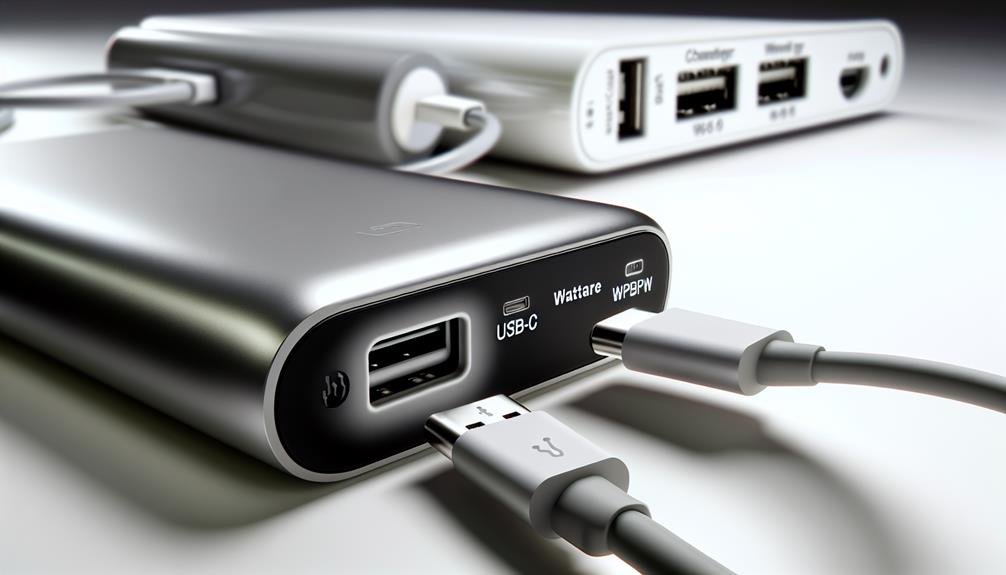
To guarantee efficient charging, you'll need to take into account the charger's output ratings, as they must align with the power bank's requirements. Additionally, the quality of the cable is essential for maintaining peak current flow and preventing energy loss. Always make sure both the charger and cable meet relevant safety compliance standards to avoid potential hazards.
Charger Output Ratings
Understanding charger output ratings is crucial for maximizing the use of a compatible charger to rapidly charge your power bank effectively. First and foremost, you need to check the voltage compatibility between your charger and power bank. Mismatched voltages can result in slower charging speeds or even potential damage. The charger's power output, measured in watts (W), directly influences charging efficiency. For example, a charger with a higher wattage will typically charge your power bank more quickly.
When selecting a charger, consider the following factors to ensure peak performance and safety:
- Voltage Rating: Confirm the charger's voltage matches the power bank's requirements.
- Amperage: Higher amperage can lead to quicker charging but must be within the power bank's tolerance.
- Power Delivery (PD): Chargers with PD support can adjust voltage and current for efficient charging.
- Certifications: Look for safety certifications like UL, CE, or FCC to guarantee the charger meets safety standards.
- Heat Dissipation: Effective chargers will manage heat well, reducing the risk of overheating.
Cable Quality Matters
While an essential charger is vital for rapid charging, the quality of the charging cable also greatly impacts the efficiency and speed of charging your power bank. It's not just about plugging in any cable; you need a high-grade one to guarantee peak performance. Inferior cables can bottleneck the charging process, resulting in slower charging times.
Cable durability is another crucial factor. A sturdy cable will withstand wear and tear, maintaining its performance over time. Look for cables with reinforced connectors and high-grade insulation to prevent fraying and internal damage. This not only enhances charging speed but also ensures safety by reducing the risk of short circuits or overheating.
Here's a comparison table to illustrate the impact of different cable qualities:
| Cable Type | Impact on Charging |
|---|---|
| High-Grade Cable | Faster charging, safe use |
| Low-Grade Cable | Slower charging, potential risk |
| Sturdy Cable | Long-lasting, reliable speed |
| Non-Sturdy Cable | Frequent replacements needed |
| Certified Cable | Meets safety standards |
Using a high-grade, sturdy cable that's compatible with your power bank and charger will maximize charging speed and enhance safety. Always choose cables that meet industry standards to ensure you're not sacrificing performance or safety.
Safety Compliance Standards
When selecting a charger for your power bank, adhering to safety compliance standards is crucial for both performance and safety. Using a compliant charger not only maximizes charging speed but also guarantees the longevity and efficiency of your power bank. Chargers that meet recognized safety standards reduce the risk of overcharging, overheating, and short-circuiting.
To confirm your charger meets necessary safety regulations, look for the following:
- UL (Underwriters Laboratories) Certification: This indicates the charger has undergone stringent testing for safety and performance.
- CE Marking: Conformance with European safety, health, and environmental protection standards.
- FCC Certification: Ensures the charger follows electromagnetic interference standards.
- RoHS (Restriction of Hazardous Substances) Compliance: Indicates the charger is devoid of specific hazardous materials.
- Energy Star Rating: Certifies the charger is energy-efficient, decreasing power wastage.
These certifications collectively contribute to the power bank's efficiency and safety. Always verify these compliance markings on the charger before making a purchase. By prioritizing safety standards and compliance regulations, you safeguard not only your device but also your personal safety. Avoid non-compliant chargers to prevent potential hazards and ensure peak charging performance.
High-Quality Charging Cables
High-quality charging cables are essential for ensuring efficient and safe power transfer to your power bank. When selecting a cable, you should prioritize cable durability and charging efficiency. Durable cables are less likely to fray or break, guaranteeing a long-lasting connection that maintains peak performance over time. Look for cables with reinforced connectors and braided exteriors, as these features enhance durability and reduce wear and tear.
Charging efficiency is another critical factor. High-quality cables minimize resistance, allowing for faster current flow and reduced energy loss. This guarantees your power bank charges quickly and safely. Choose cables that are certified for fast charging standards such as Quick Charge 3.0 or USB Power Delivery (USB-PD). These certifications ensure the cable can handle higher power levels without overheating or causing damage.
Additionally, make sure the cable gauge is appropriate for the power requirements of your device. Thicker cables typically offer lower resistance and better performance. Always use cables from reputable manufacturers and avoid counterfeit products, as they often lack the necessary safety features. By investing in high-quality charging cables, you can safeguard your power bank and maximize charging efficiency.
Optimal Charging Environment
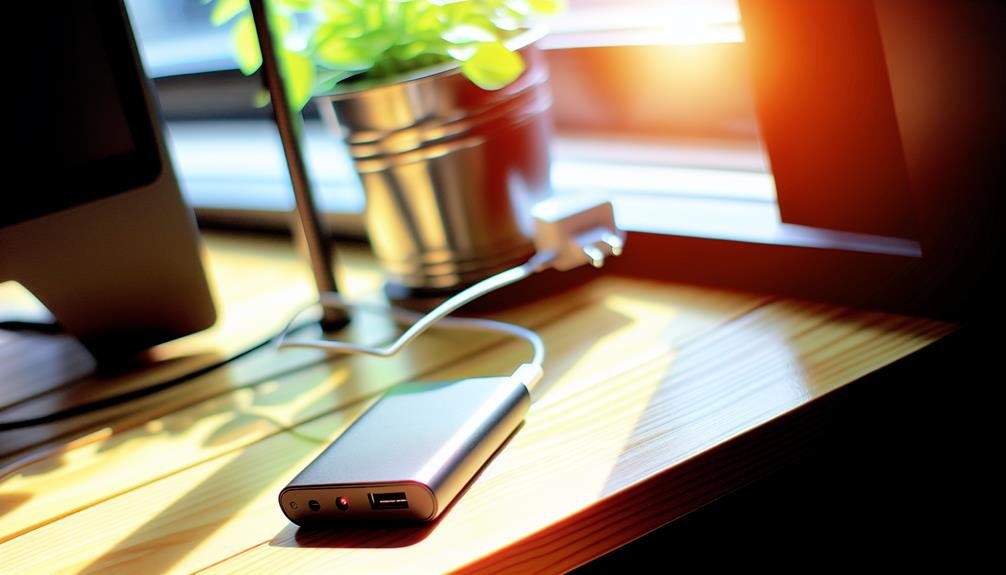
To achieve the fastest and safest charging for your power bank, it's important to consider the best charging environment. The environment where you charge your power bank plays a vital role in both charging speed and safety. Proper temperature monitoring and ideal power bank placement are essential.
Firstly, make sure your power bank is in a cool, well-ventilated area to prevent overheating. Excessive heat can slow down charging speed and damage the battery over time. Avoid placing the power bank on soft surfaces like beds or sofas, as these can impede proper ventilation.
Here are some key points to keep in mind:
- Temperature Monitoring: Keep an eye on the power bank's temperature. If it feels too hot, stop charging immediately.
- Ideal Power Bank Placement: Position the power bank on a hard, flat surface to allow air circulation around the device.
- Ventilation Requirements: Avoid enclosed spaces. Charging in a confined area can lead to heat buildup.
- Avoid Direct Sunlight: Direct exposure to sunlight can notably increase the power bank's temperature.
- Stable Electrical Source: Ensure the power outlet you're using is reliable and steady to prevent power surges.
Fast Charging Technologies
Considering the best charging environment is just one piece of the puzzle, let's now explore the fast charging technologies that can greatly reduce the time required to fully charge your power bank. Fast charging benefits include notably shorter charging times, enabling you to quickly replenish your power bank, which is essential in emergencies or during travel.
One of the latest innovations in fast charging is Qualcomm's Quick Charge technology. This protocol allows for higher power transfer rates, resulting in faster charging cycles. Similarly, USB Power Delivery (USB-PD) is a versatile standard that adjusts power levels to optimize charging efficiency across a wide range of devices, including power banks.
Another remarkable technology is Oppo's SuperVOOC, which employs sophisticated voltage and current management to achieve impressive charging speeds while maintaining safety. Lithium Polymer (Li-Po) batteries are also becoming more common in power banks, offering higher energy densities and faster charge times compared to traditional Lithium-Ion (Li-Ion) batteries.
While these technologies offer impressive fast charging benefits, they also incorporate safety features such as temperature control and over-voltage protection, ensuring your power bank charges safely. By leveraging these latest innovations, you can achieve rapid and secure charging performance.
Battery Management Tips
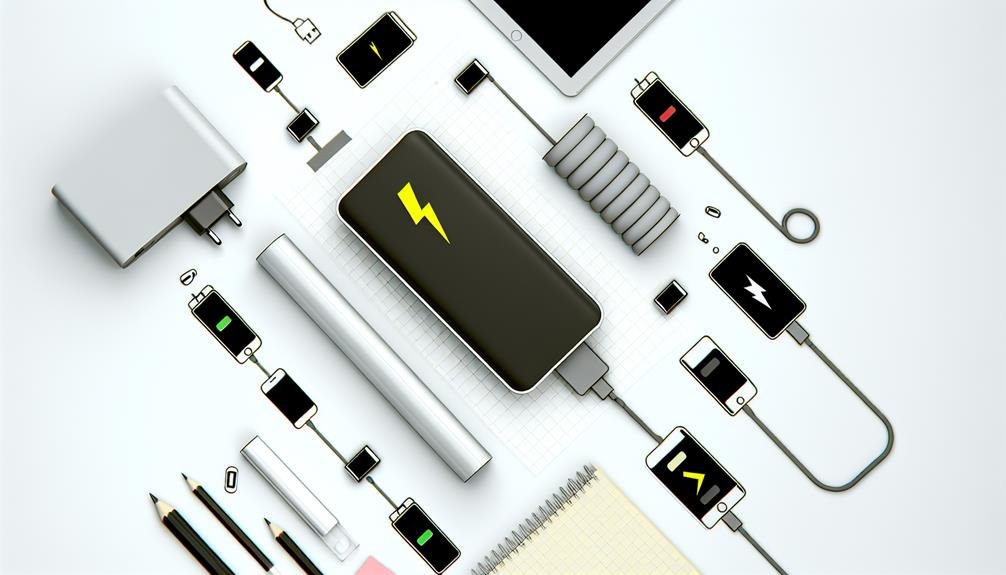
Effective battery management is important for maintaining your power bank's longevity and ensuring the best performance. Adopting good battery maintenance practices can greatly enhance your device's lifespan and efficiency. Start by cultivating ideal charging habits. Here are some key practices to keep in mind:
- Avoid Full Discharges: Do not wait until your power bank is completely drained before recharging it. Lithium-ion batteries benefit from partial discharges.
- Regular Usage: Use your power bank regularly. Prolonged inactivity can cause the battery to lose its charge capacity over time.
- Store Properly: Keep your power bank in a cool, dry place. Extreme temperatures can degrade the battery's effectiveness.
- Use Quality Chargers: Always use the charger that came with your power bank or a high-quality alternative. Poor-quality chargers can damage the battery.
- Monitor Charge Levels: Don't leave your power bank plugged in after it's fully charged. Overcharging can cause stress on the battery cells.
Avoiding Overheating
To prevent overheating during fast charging, you should use chargers with high efficiency and built-in safety mechanisms. Additionally, regularly monitor the power bank's temperature to guarantee it doesn't exceed safe operating limits. Employing these strategies will extend your power bank's lifespan and sustain peak performance.
Choose Efficient Chargers
Selecting high-efficiency chargers can greatly reduce the risk of your power bank overheating during the charging process. These chargers optimize both charging speed and power efficiency, making sure that your power bank reaches full charge quickly without generating excessive heat. Using a charger specifically designed for fast charging can minimize energy loss, thereby reducing thermal output.
When choosing an efficient charger, consider the following:
- Compatibility: Confirm the charger is compatible with your power bank's input requirements to maximize charging speed and efficiency.
- Wattage: Choose a charger with appropriate wattage; higher wattage chargers can deliver power faster, reducing overall charge time and heat buildup.
- Technology: Seek chargers with advanced technologies like Qualcomm Quick Charge or USB Power Delivery (PD) for enhanced power efficiency.
- Build Quality: A well-constructed charger with good ventilation can dissipate heat more effectively, preventing overheating.
- Brand Reputation: Opt for reputable brands known for their high-quality components and safety features.
Monitor Charging Temperature
Monitoring the charging temperature is vital to ensure your power bank doesn't overheat, which can lead to diminished battery life or even safety hazards. Overheating can cause irreversible damage to the internal components, compromising both performance and safety. Implementing robust safety measures is crucially important.
Firstly, always use a charger that matches the power bank's specifications. Using a mismatched charger can result in excessive heat generation. Make sure the power bank is placed in a well-ventilated area during charging. Avoid covering it with any material that could trap heat, such as blankets or clothes.
Invest in power banks equipped with built-in temperature monitoring systems. These devices can automatically regulate the charging process, shutting down if the charging temperature exceeds safe limits. Additionally, regularly check the power bank's surface temperature manually. If it feels excessively hot to the touch, immediately disconnect it from the charger.
Regular Firmware Updates
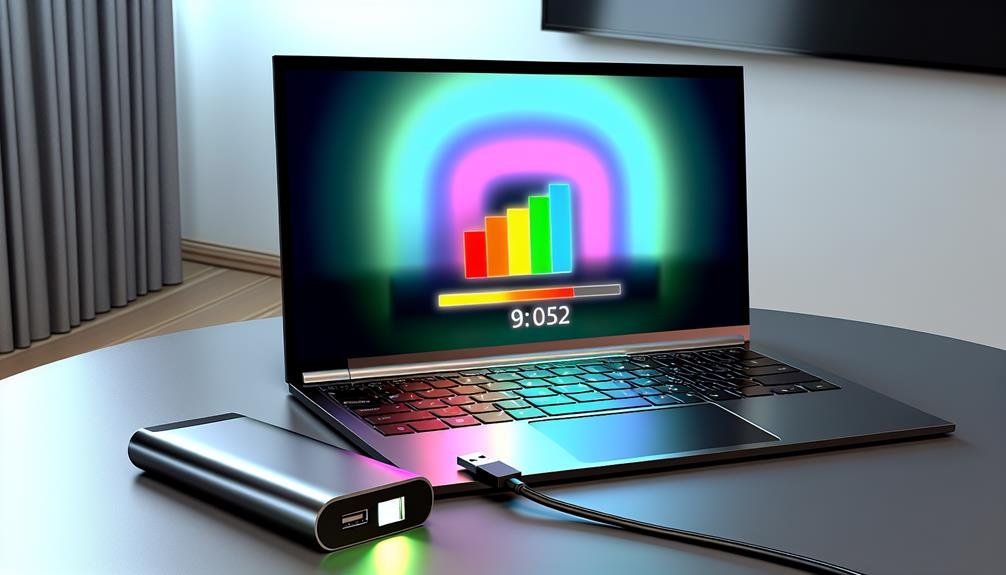
Maintaining your power bank's regular firmware updates is essential for preserving peak charging efficiency and security. Firmware updates not only improve the performance of your power bank but also optimize battery health, contributing to power bank longevity. Keeping your device's firmware current is an important aspect of power bank maintenance that you shouldn't overlook.
Firmware updates can:
- Enhance charging speed and efficiency.
- Rectify bugs and glitches that may impede performance.
- Boost security features to safeguard against vulnerabilities.
- Optimize battery management systems for extended battery life.
- Introduce new functionalities and compatibility with newer devices.
To make sure your power bank's firmware is up-to-date, regularly check the manufacturer's website or the accompanying mobile app for updates. Many power banks come with an app that notifies you of available firmware updates and provides a simple process for installation. Disregarding these updates can result in less than optimal charging speeds and potential security risks.
Safety Precautions
When fast charging a power bank, you must avoid overheating risks by ensuring adequate ventilation and not using the device in high-temperature environments. Always use certified chargers to maintain voltage and current within safe limits. Additionally, monitor the charging environment to prevent exposure to moisture or flammable materials.
Avoid Overheating Risks
Proper heat management is essential to prevent thermal runaway and guarantee the longevity of your power bank during fast charging. When charging at high speeds, it's critical to maintain temperature control to avoid overheating. Rapid charging can generate significant heat, which, if not adequately addressed, can damage the internal components of your power bank and pose safety risks.
To effectively prevent overheating during rapid charging, consider the following precautions:
- Avoid blocking ventilation: Make sure that the power bank is placed in a well-ventilated area. Blocking air flow can trap heat and elevate internal temperatures.
- Monitor temperature: Regularly check the power bank's temperature. If it feels excessively hot to the touch, unplug it and allow it to cool down before continuing to charge.
- Avoid high ambient temperatures: Charging in a cool environment helps dissipate heat more efficiently. Avoid charging your power bank in direct sunlight or near other heat sources.
- Use built-in safety features: Many modern power banks come with built-in temperature control features. Familiarize yourself with these functions and confirm they are activated.
- Avoid continuous high-speed charging: Alternate between normal and high-speed charging sessions to give the power bank time to cool down.
Use Certified Chargers
Equally important to preventing overheating is using approved chargers to guarantee the safety and efficiency of your power bank during fast charging. Approved chargers are designed to meet specific safety standards that protect both your power bank and yourself. When you use a non-certified charger, you risk inconsistent charging speeds, potential damage to your device, and even safety hazards such as electrical fires.
Approved chargers ensure best charging speed while maintaining the integrity of your power bank's battery. They regulate the voltage and current flow, preventing any surges that could lead to overheating or damage. It's important to check for power bank certification labels like UL, CE, or FCC, which indicate that the charger has been tested and meets industry safety standards.
Moreover, approved chargers enhance charging efficiency. Efficiency here refers to the charger's ability to convert electrical energy from the grid to your power bank without unnecessary loss. An efficient charger not only reduces the charging time but also minimizes heat generation, further contributing to safety.
Monitor Charging Environment
To guarantee the safety and longevity of your power bank, always monitor the charging environment to avoid exposure to extreme temperatures or humidity. Making sure that your device is in an ideal environment is essential for maintaining its efficiency and preventing potential hazards. Charging speed can be greatly impacted by the surrounding conditions, and improper environments can even lead to battery damage or reduced lifespan.
Key considerations include:
- Temperature Control: Keep the power bank in a cool, dry place. Avoid areas that can overheat, such as direct sunlight or near heating appliances.
- Humidity Levels: Moisture can cause internal short circuits. Place the power bank in a low-humidity environment to minimize the risk.
- Ventilation: Ensure that the area around the power bank is well-ventilated. This helps dissipate heat generated during fast charging.
- Stable Surface: Position the power bank on a flat, stable surface. This prevents it from falling, which could cause physical damage and reduce charging efficiency.
- Away from Flammable Materials: Keep the power bank away from flammable objects to mitigate fire risks in case of overheating.
Frequently Asked Questions
How Can I Tell if My Power Bank Is Fast Charging?
You'll know if your power bank is fast charging by checking the charging indicators. Compare the charging speeds with the power bank's specs. If it's charging notably quicker than usual, it's likely in fast charge mode.
What Are the Signs of a Faulty Power Bank?
You're dealing with a faulty power bank if it overheats, swells, or fails to charge devices properly. For power bank maintenance and troubleshooting, common issues include battery degradation and circuitry faults. Solutions involve professional inspection and potential replacement.
Can I Use My Phone While Charging the Power Bank?
Yes, you can use your phone while charging the power bank—if you enjoy multitasking limitations and reduced charging efficiency. But seriously, it's best to avoid it to guarantee safety and peak power bank charging.
How Long Does It Typically Take to Fast Charge a Power Bank?
Typically, the charging speed and battery capacity determine how long it takes to fast charge a power bank. Charging indicators help with time estimation, but it usually ranges from 2 to 4 hours for most models.
What Should I Do if My Power Bank Isn't Charging Properly?
If your power bank isn't charging properly, don't throw in the towel yet. First, check device compatibility and charging indicators. Use these troubleshooting tips: inspect cables, try different outlets, and consult the manual for charging solutions.

